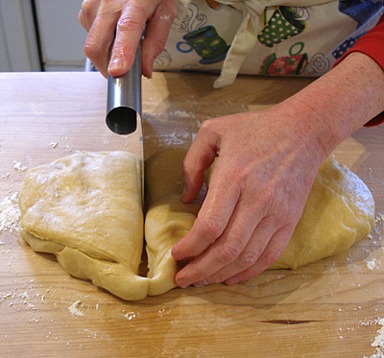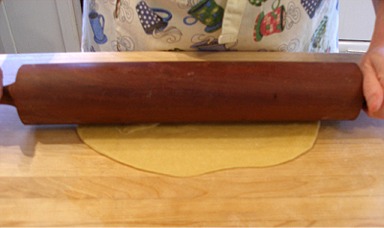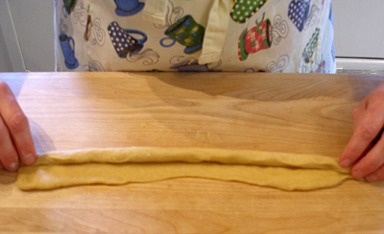.jpg}) Instead of forming dough snakes for braided bread by rolling dough on a work surface between your palms, this technique ensures a more compact strand, a tighter braid, and as a result, as better bread that keeps its shape during baking. The strands also do not puff up as much, preventing the white part of the bread peaking from beneath the braid, as it rises (ovenspring) and bakes, without a sharp color contrast to the dark brown crust.
Instead of forming dough snakes for braided bread by rolling dough on a work surface between your palms, this technique ensures a more compact strand, a tighter braid, and as a result, as better bread that keeps its shape during baking. The strands also do not puff up as much, preventing the white part of the bread peaking from beneath the braid, as it rises (ovenspring) and bakes, without a sharp color contrast to the dark brown crust.
It is similar to a technique used when making filled bread. I use this baking technique is used when making my egg-rich and moist Challah Bread from a Starter recipe. See also How to Braid Six Strand Bread.
HOW TO TIPS
1. After deflating the dough from its first rise, for example, cut the dough into six equal pieces. Set them aside and cover loosely with plastic wrap so the bread dough's surface will not dry.
SARAH SAYS: You can use a kitchen scale to make sure every dough piece is even in weight.

2. Brush the flour off the work surface. Have a small bowl of room temperature tap water handy.
3. Without using ANY flour, roll a piece of dough with a rolling pin into a very thin sheet, between 1/8 and 1/4-inch thick.
Don't worry about making a rectangle; an amoeba-type shape is fine.
The dough may stick to the work surface; if it does, just nudge it gently with a dough scraper.

4. Tightly roll up the sheet like a carpet to form a strand.

5. Roll the strand back and forth between your hands until it's thin, very even, snake shape, about and 12 to 15-inches long.
At the ends of the strand, angle the outer edge of your hands into the work surface as you're rolling to make the ends pointy and the strand thicker in the middle.
(This will help you get a football-shaped loaf).

NOTE: The strand needs to grip the work surface slightly during this rolling; the grab will help as you roll. If the strand is too slick, very lightly dampen it with
water to help it grip the work surface better.
6. Set the finished strand aside and cover loosely with plastic wrap.
7. Repeat the rolling out, rolling up, and elongating steps with the remaining five pieces of dough, rolling them out to the same length.
Cover loosely with plastic wrap until needed.


